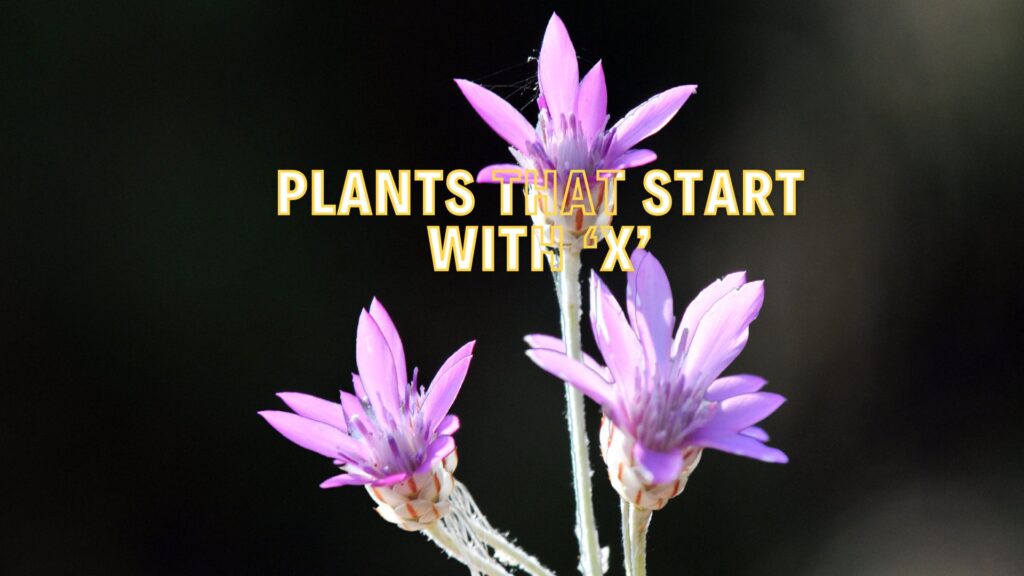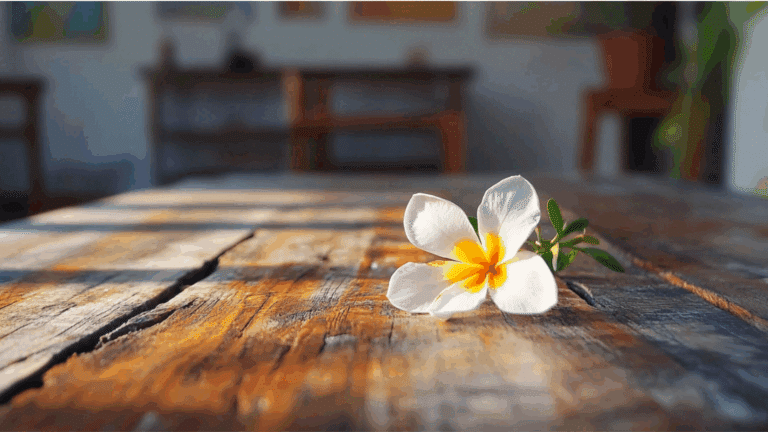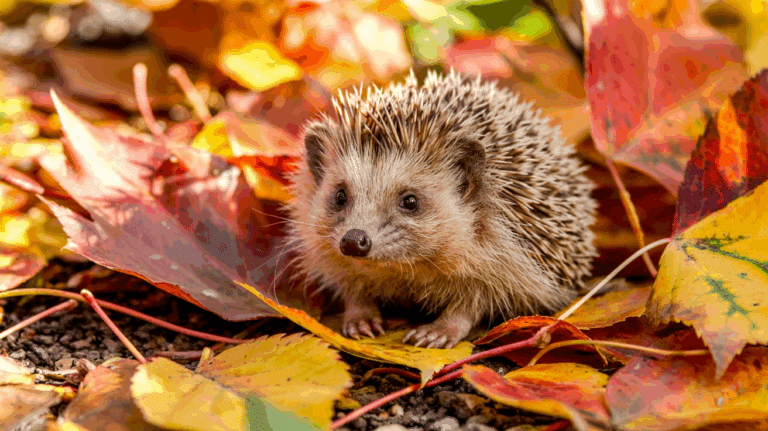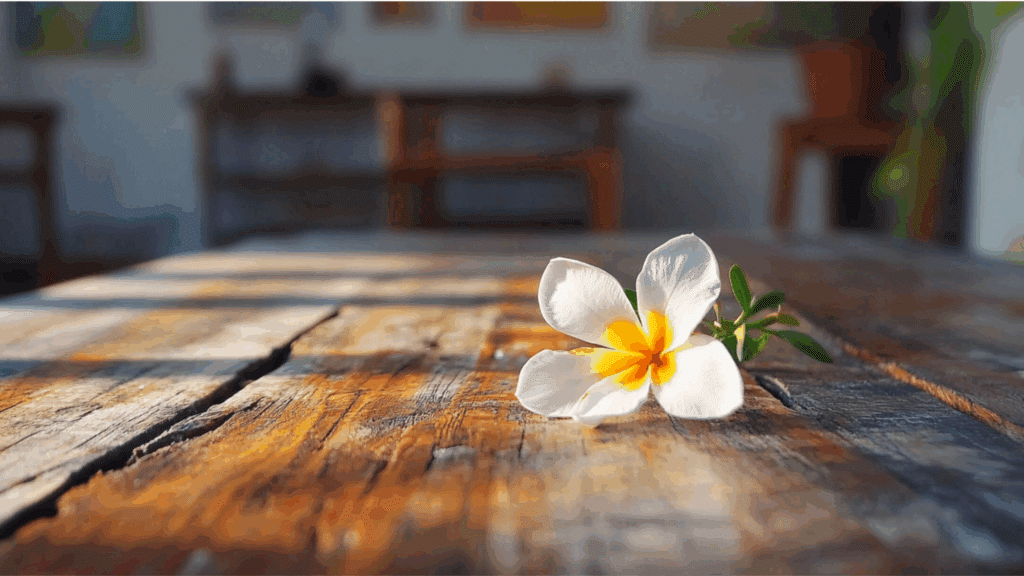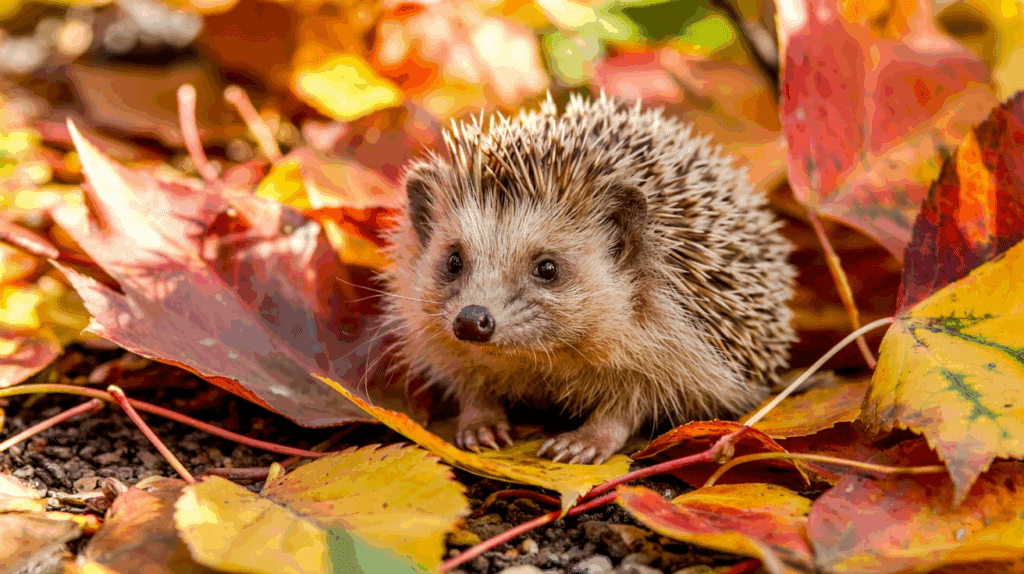Let’s talk about plants that start with X. I know finding these can be tricky. There aren’t many common plants beginning with this letter, which can limit gardening choices. I’ve got good news for you, though.
There are more X-starting plants than you might think. This article will introduce you to a world of gardening options you may not have known.
I’ll show you over 33 plants that start with X. From flowers to trees, herbs to shrubs, we’ll cover a range of options for your garden.
Whether you’re looking to add something unique or just curious about X-plants, you’ll find plenty of ideas here.
Let’s explore these interesting plants together.
1. Xanthoceras sorbifolium
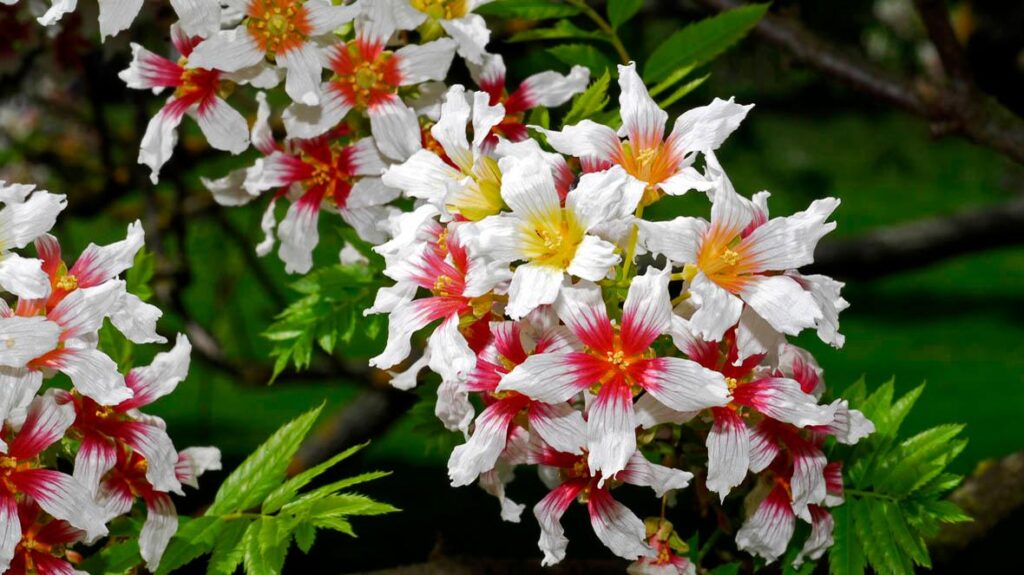
Xanthoceras sorbifolium, also known as yellowhorn, features white flowers with a splash of red at the base of the petals.
It is a deciduous shrub or small tree with pinnate leaves.
| Scientific Name | Xanthoceras sorbifolium |
|---|---|
| Origin | China |
| Light | Full sun |
| Temperature | -30°C to 30°C |
| Watering | Moderate |
| Soil | Well-drained |
Fun Facts:
- The seeds are edible and can be roasted or boiled.
- It is used in traditional Chinese medicine.
- The tree is also known for its ornamental value due to its beautiful flowers.
2. Xanthostemon chrysanthus
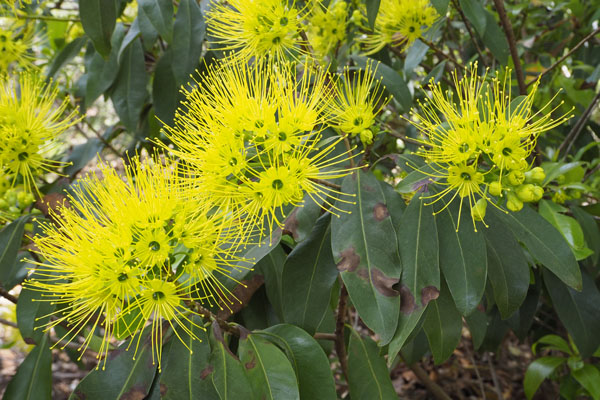
Xanthostemon chrysanthus, commonly known as golden penda, displays striking yellow flowers that form dense clusters.
It is an evergreen tree with glossy green leaves.
| Scientific Name | Xanthostemon chrysanthus |
|---|---|
| Origin | Australia |
| Light | Full sun |
| Temperature | 10°C to 35°C |
| Watering | Moderate |
| Soil | Well-drained, sandy |
Fun Facts:
- It attracts bees, butterflies, and birds with its nectar-rich flowers.
- The tree is often used in landscaping for its vibrant color.
- Golden penda can grow up to 10 meters tall.
3. Xeranthemum annuum
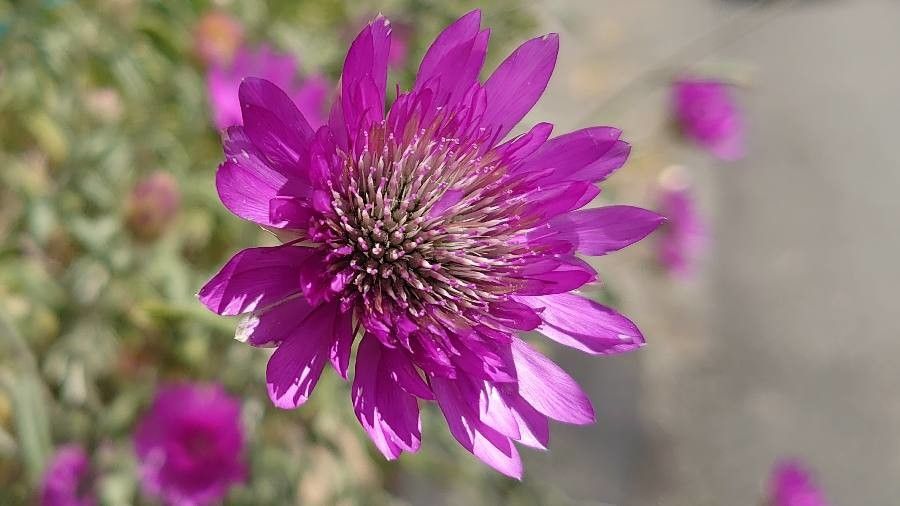
Xeranthemum annuum, known as immortelle, has papery, daisy-like flowers that can be pink, purple, or white.
It is an annual plant with silvery-green foliage.
| Scientific Name | Xeranthemum annuum |
|---|---|
| Origin | Mediterranean |
| Light | Full sun |
| Temperature | 5°C to 30°C |
| Watering | Low |
| Soil | Well-drained, sandy |
Fun Facts:
- The flowers retain their color and shape when dried.
- Often used in dried flower arrangements.
- It is a low-maintenance plant suitable for dry climates.
4. Xerosicyos danguyi
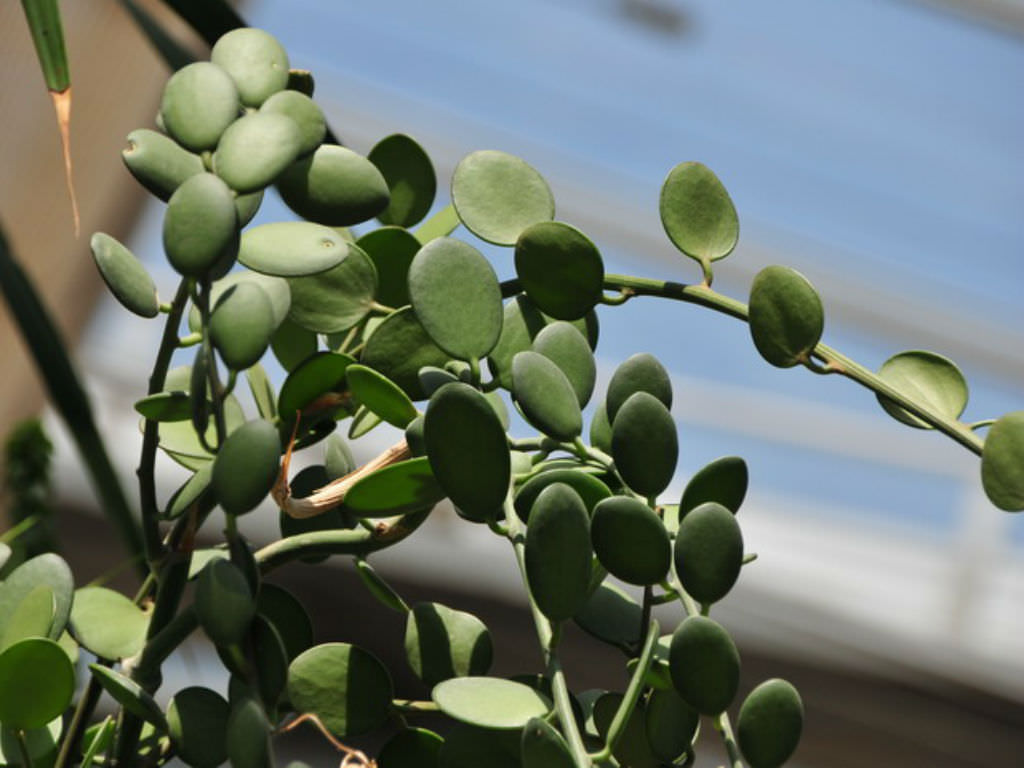
Xerosicyos danguyi, also known as the silver dollar plant, has round, succulent leaves that resemble silver dollars.
It is a climbing plant with a woody stem.
| Scientific Name | Xerosicyos danguyi |
|---|---|
| Origin | Madagascar |
| Light | Full sun to partial shade |
| Temperature | 10°C to 30°C |
| Watering | Low |
| Soil | Well-drained, sandy |
Fun Facts:
- It is a member of the cucumber family.
- The plant is drought-tolerant.
- Often grown as a houseplant or in xeriscape gardens.
5. Xylosma congestum
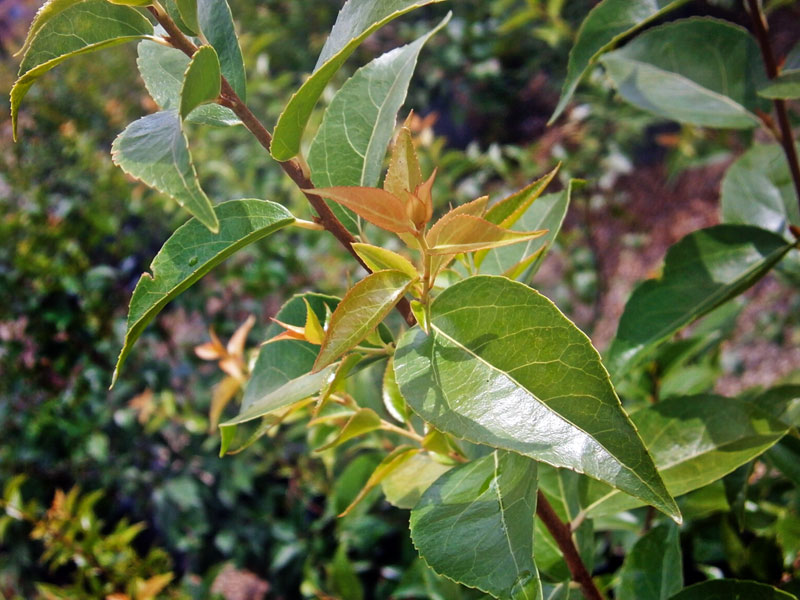
Xylosma congestum, also known as shiny xylosma, is an evergreen shrub with glossy, dark green leaves.
It produces small yellow flowers followed by black berries.
| Scientific Name | Xylosma congestum |
|---|---|
| Origin | China |
| Light | Full sun to partial shade |
| Temperature | -5°C to 30°C |
| Watering | Moderate |
| Soil | Well-drained |
Fun Facts:
- Often used as a hedge or ornamental shrub.
- The berries are attractive to birds.
- It is low-maintenance and adaptable to various soils.
6. Xylopia aethiopica
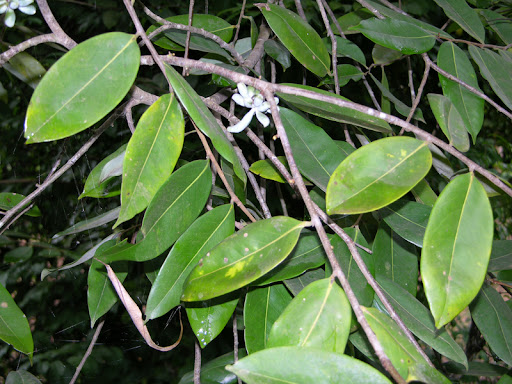
Xylopia aethiopica, known as Ethiopian pepper or grains of Selim, is a tropical tree that produces aromatic, peppery fruits.
The leaves are lance-shaped and glossy.
| Scientific Name | Xylopia aethiopica |
|---|---|
| Origin | West Africa |
| Light | Full sun |
| Temperature | 15°C to 30°C |
| Watering | Moderate |
| Soil | Well-drained |
Fun Facts:
- The fruits are used as a spice in African cuisine.
- It has medicinal properties and is used in traditional medicine.
- The tree can grow up to 20 meters tall.
7. Xyris indica
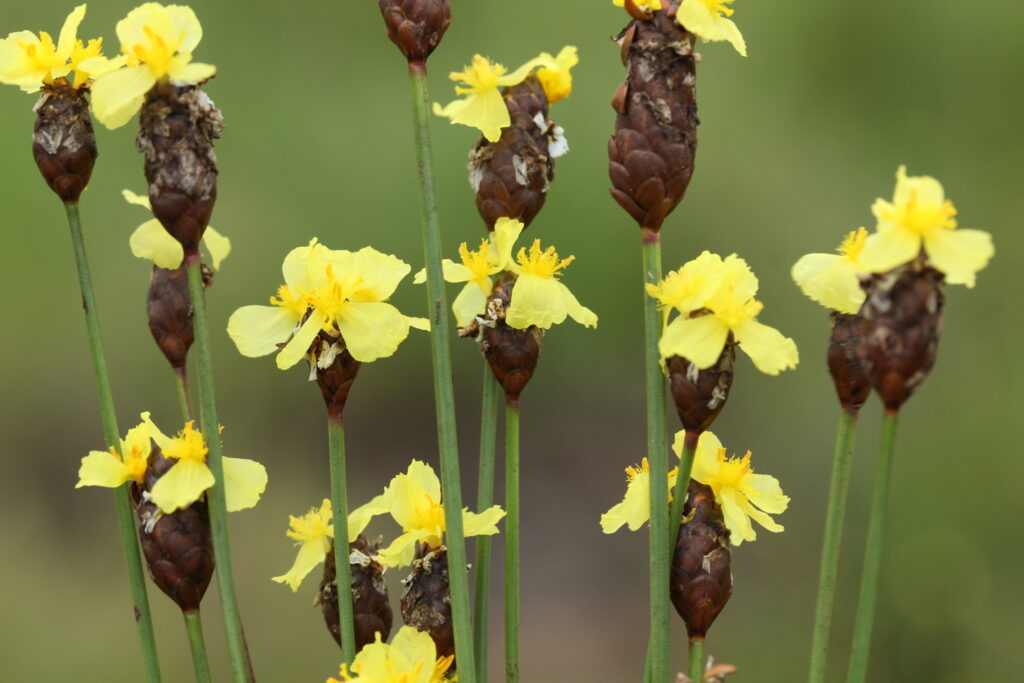
Xyris indica, also known as yellow-eyed grass, has bright yellow flowers that bloom on slender stems.
The plant has grass-like leaves and prefers wet conditions.
| Scientific Name | Xyris indica |
|---|---|
| Origin | Southeast Asia |
| Light | Full sun |
| Temperature | 15°C to 30°C |
| Watering | High |
| Soil | Wet, boggy |
Fun Facts:
- Often found in wetlands and marshy areas.
- The flowers open only for a few hours each day.
- It is used in traditional medicine in some cultures.
8. Xerophyllum asphodeloides
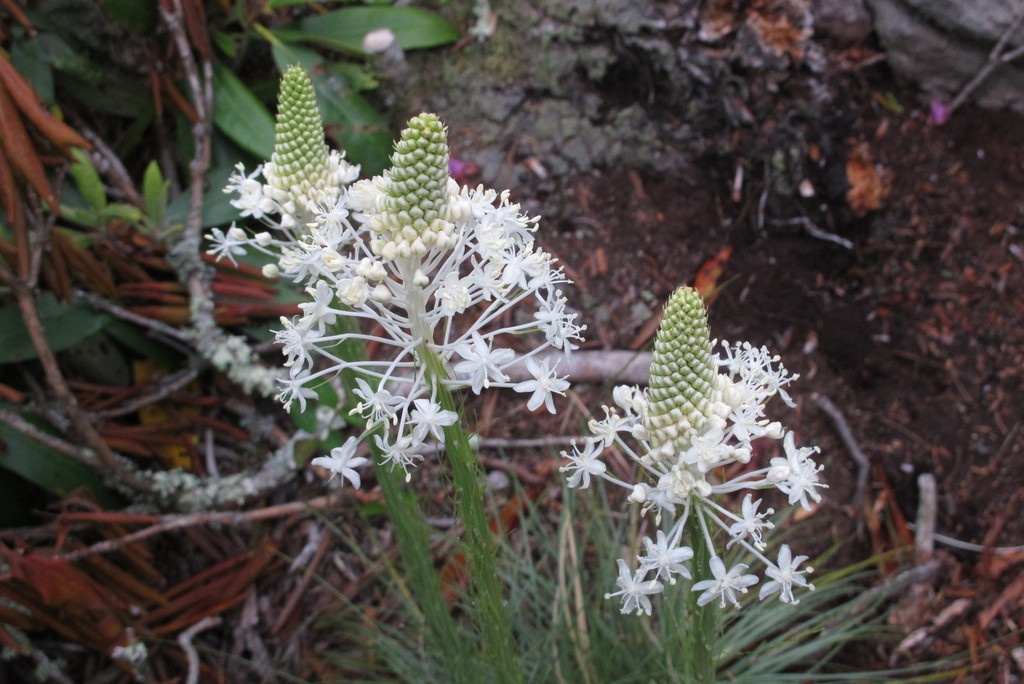
Xerophyllum asphodeloides, commonly known as turkey beard, features white, star-shaped flowers that form dense clusters.
The plant has grass-like, evergreen leaves.
| Scientific Name | Xerophyllum asphodeloides |
|---|---|
| Origin | North America |
| Light | Full sun to partial shade |
| Temperature | -20°C to 30°C |
| Watering | Moderate |
| Soil | Well-drained, sandy |
Fun Facts:
- It is a fire-resistant plant.
- Often found in pine barrens and sandy soils.
- The flowers attract various pollinators.
9. Xanthorhiza simplicissima
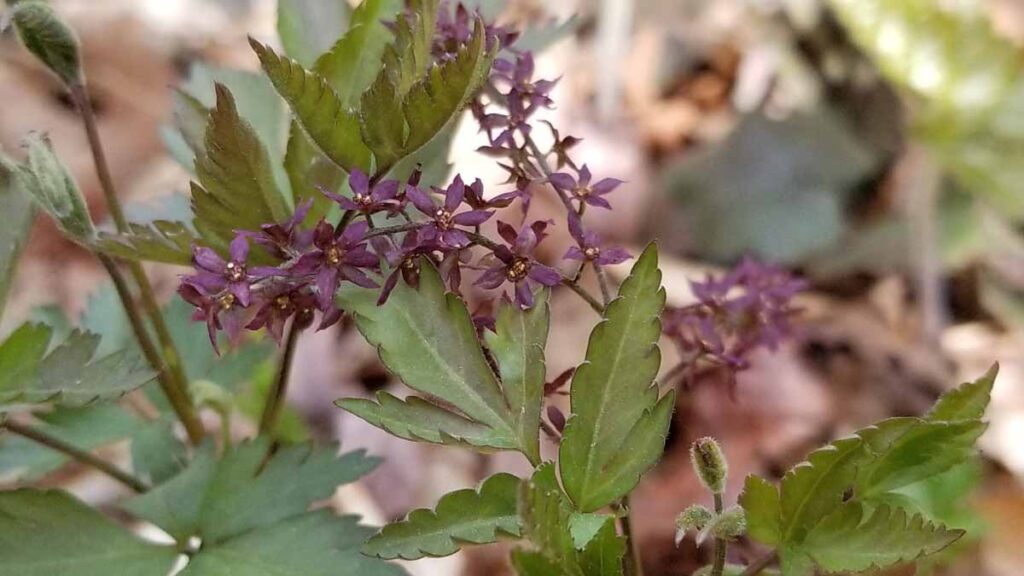
Xanthorhiza simplicissima, known as yellowroot, has slender, woody stems with clusters of small, star-shaped purple flowers.
The leaves are pinnately compound and green.
| Scientific Name | Xanthorhiza simplicissima |
|---|---|
| Origin | North America |
| Light | Full sun to partial shade |
| Temperature | -20°C to 30°C |
| Watering | Moderate |
| Soil | Well-drained, moist |
Fun Facts:
- The root contains a yellow dye.
- It is used in herbal medicine.
- Often found in wooded, moist areas.
10. Xanthosoma sagittifolium
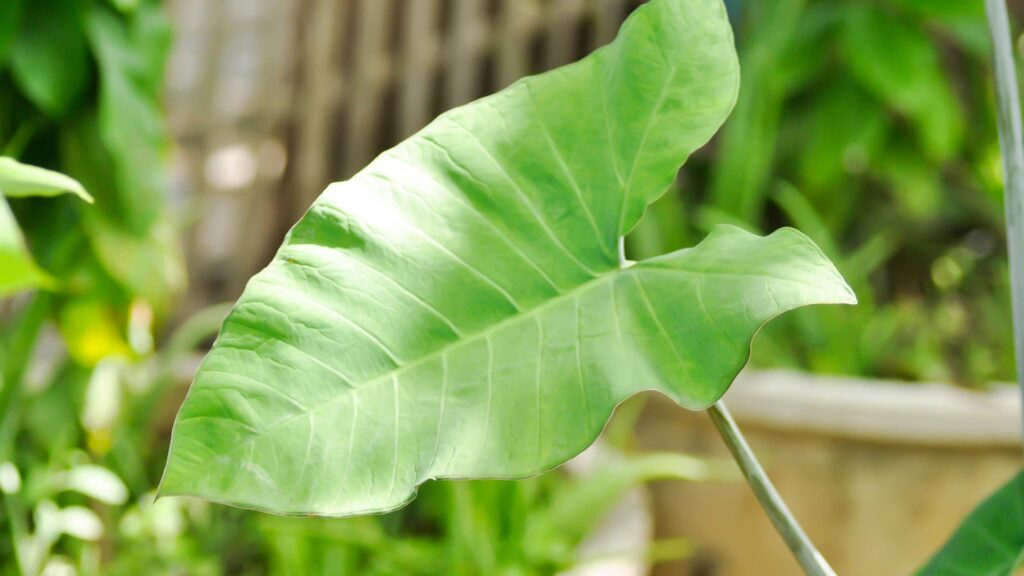
Xanthosoma sagittifolium, also known as malanga or tannia, has large, arrow-shaped leaves and tuberous roots.
The plant is grown for its edible corms.
| Scientific Name | Xanthosoma sagittifolium |
|---|---|
| Origin | Tropical Americas |
| Light | Full sun to partial shade |
| Temperature | 15°C to 35°C |
| Watering | High |
| Soil | Well-drained, rich |
Fun Facts:
- The corms are a staple food in many tropical countries.
- It can be grown as an ornamental plant.
- The leaves can be used as a spinach substitute.
11. Xylomelum pyriforme
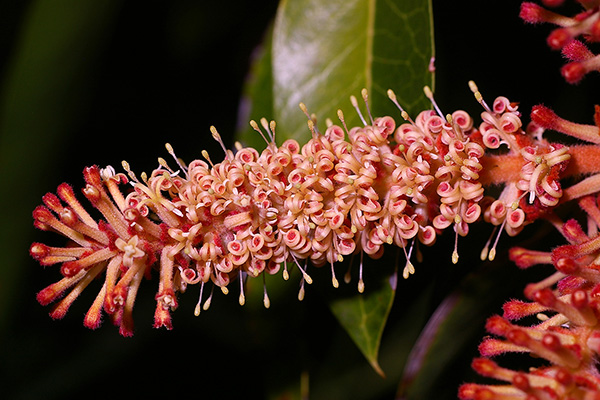
Xylomelum pyriforme, commonly known as woody pear, produces large, pear-shaped fruits.
The plant has leathery, lance-shaped leaves and white to cream-colored flowers.
| Scientific Name | Xylomelum pyriforme |
|---|---|
| Origin | Australia |
| Light | Full sun |
| Temperature | 5°C to 30°C |
| Watering | Low |
| Soil | Well-drained, sandy |
Fun Facts:
- The fruit is woody and not edible.
- It is a member of the Proteaceae family.
- Often found in dry sclerophyll forests.
12. Xerophyta retinervis
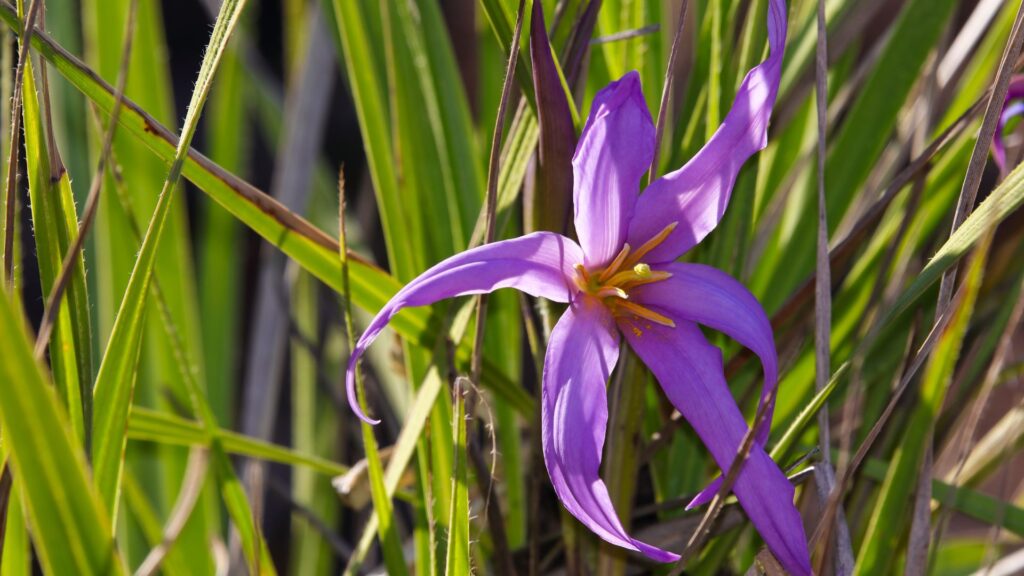
Xerophyta retinervis, known as black-stick lily, has grass-like leaves and produces purple or white flowers. The plant can survive extreme drought conditions.
| Scientific Name | Xerophyta retinervis |
|---|---|
| Origin | Southern Africa |
| Light | Full sun |
| Temperature | 10°C to 35°C |
| Watering | Low |
| Soil | Well-drained, rocky |
Fun Facts:
- It is a resurrection plant, reviving after desiccation.
- Often found in rocky, mountainous areas.
- The plant can live for many years.
13. Xylopia aromatic
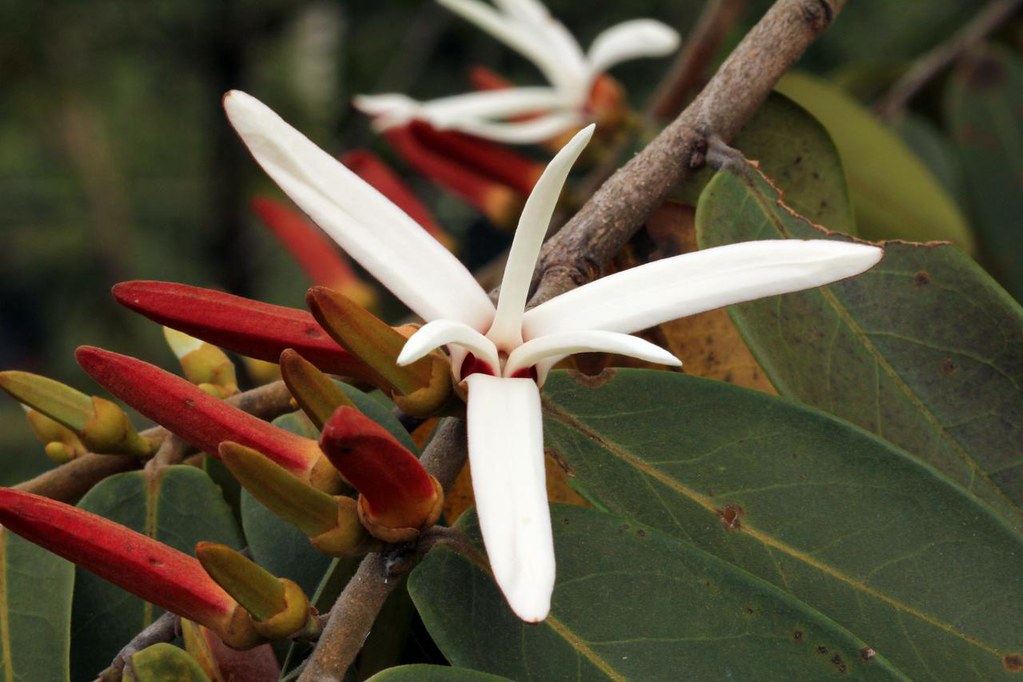
Xylopia aromatica, also known as aromatic xylopia, has lance-shaped leaves and produces small, fragrant flowers.
The tree is known for its aromatic properties.
| Scientific Name | Xylopia aromatica |
|---|---|
| Origin | South America |
| Light | Full sun |
| Temperature | 15°C to 30°C |
| Watering | Moderate |
| Soil | Well-drained |
Fun Facts:
- The bark and leaves are used in traditional medicine.
- It is known for its pleasant fragrance.
- The tree can grow up to 15 meters tall.
14. Xanthium strumarium
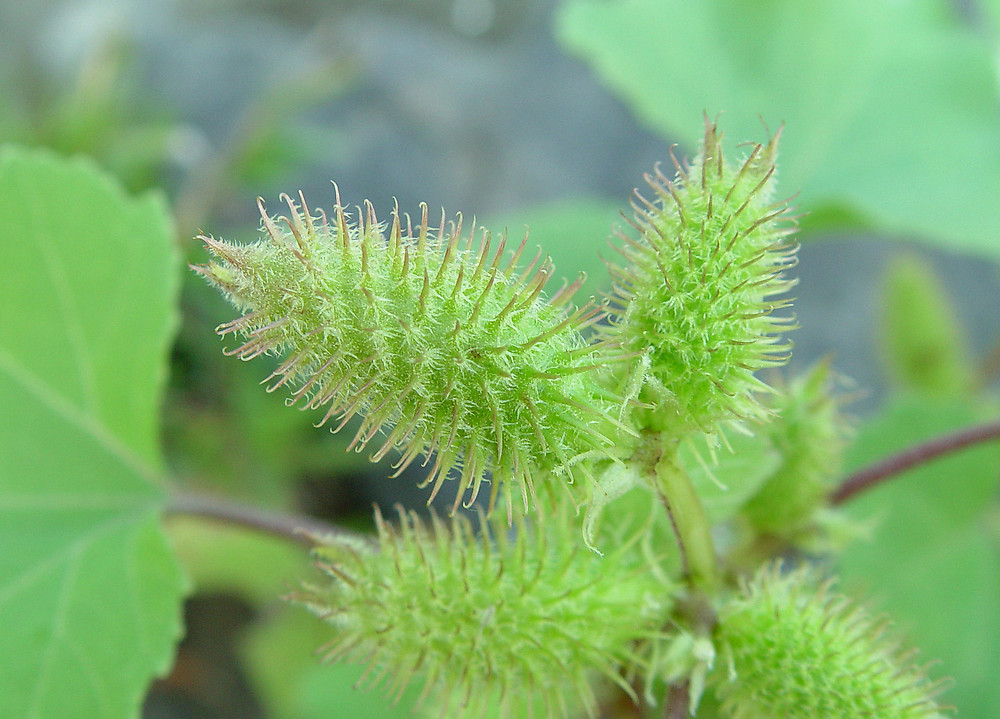
Xanthium strumarium, known as common cocklebur, has rough, heart-shaped leaves and produces spiny burs.
The plant is considered a weed in many areas.
| Scientific Name | Xanthium strumarium |
|---|---|
| Origin | North America |
| Light | Full sun |
| Temperature | 5°C to 30°C |
| Watering | Moderate |
| Soil | Well-drained |
Fun Facts:
- The burs can stick to animal fur and clothing.
- It has been used in traditional medicine.
- The plant is toxic to livestock if ingested.
15. Xylosma flexuosa

Xylosma flexuosa, also known as brush holly, is an evergreen shrub with small, glossy leaves and clusters of tiny, yellow-green flowers.
The plant produces small, dark berries.
| Scientific Name | Xylosma flexuosa |
|---|---|
| Origin | Central America |
| Light | Full sun to partial shade |
| Temperature | 10°C to 30°C |
| Watering | Moderate |
| Soil | Well-drained |
Fun Facts:
- Often used as a hedge or screen plant.
- The berries attract birds.
- It is drought-tolerant once established.
16. Ximenia Americana
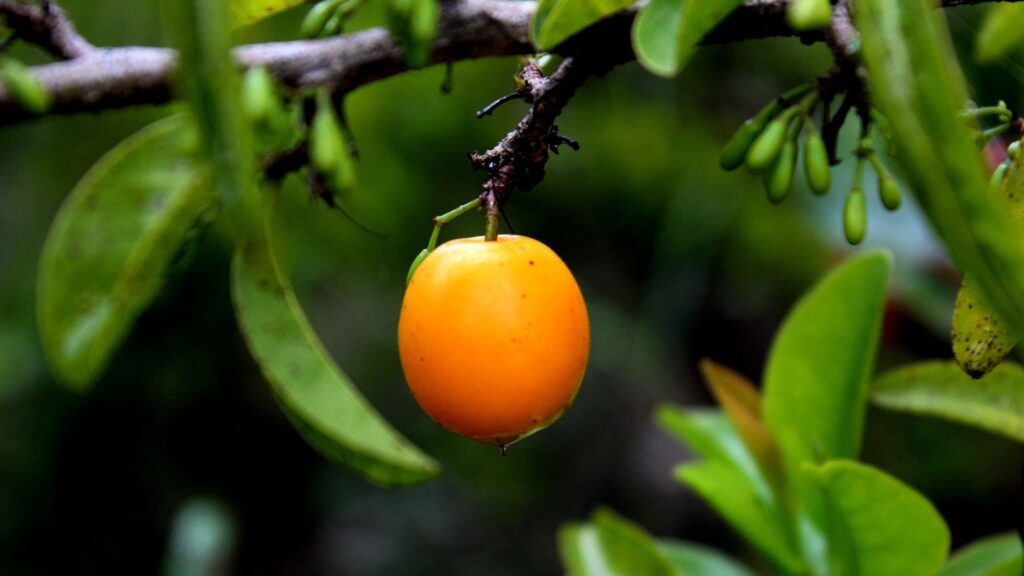
Ximenia americana, commonly known as tallow wood, has leathery, oval leaves and produces small, fragrant flowers followed by yellow to orange fruits.
| Scientific Name | Ximenia americana |
|---|---|
| Origin | Tropical regions |
| Light | Full sun |
| Temperature | 15°C to 35°C |
| Watering | Moderate |
| Soil | Well-drained |
Fun Facts:
- The fruits are edible and used in jams and jellies.
- The plant has medicinal properties.
- The wood is used for making tools and utensils.
17. Xeranthemum cylindraceum
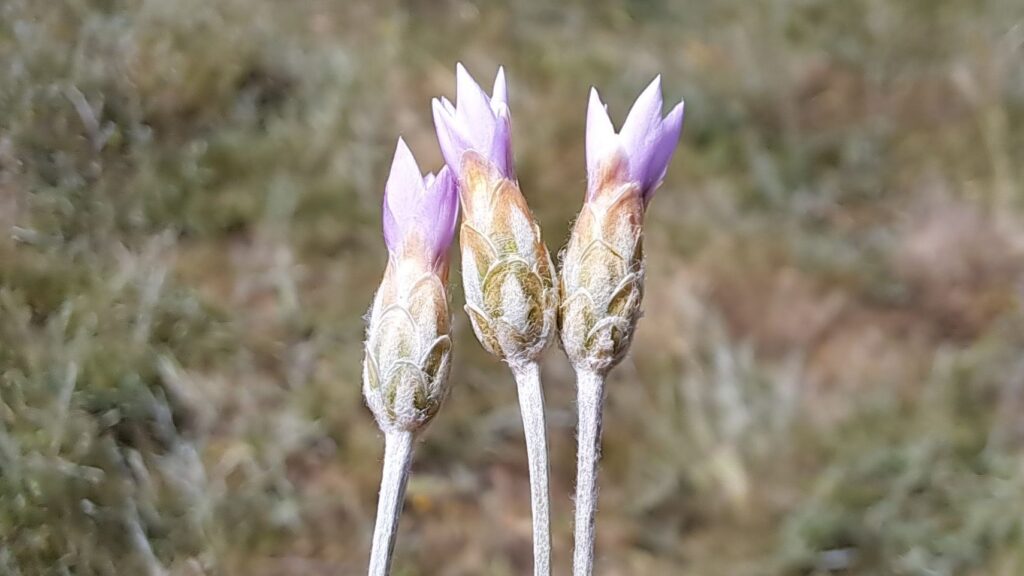
Xeranthemum cylindraceum, known as everlasting flower, has papery, cylindrical flowers that can be pink, purple, or white.
It is an annual plant with silvery foliage.
| Scientific Name | Xeranthemum cylindraceum |
|---|---|
| Origin | Mediterranean |
| Light | Full sun |
| Temperature | 5°C to 30°C |
| Watering | Low |
| Soil | Well-drained, sandy |
Fun Facts:
- The flowers retain their color when dried.
- Often used in dried flower arrangements.
- It is a low-maintenance plant.
18. Xylopia sericea
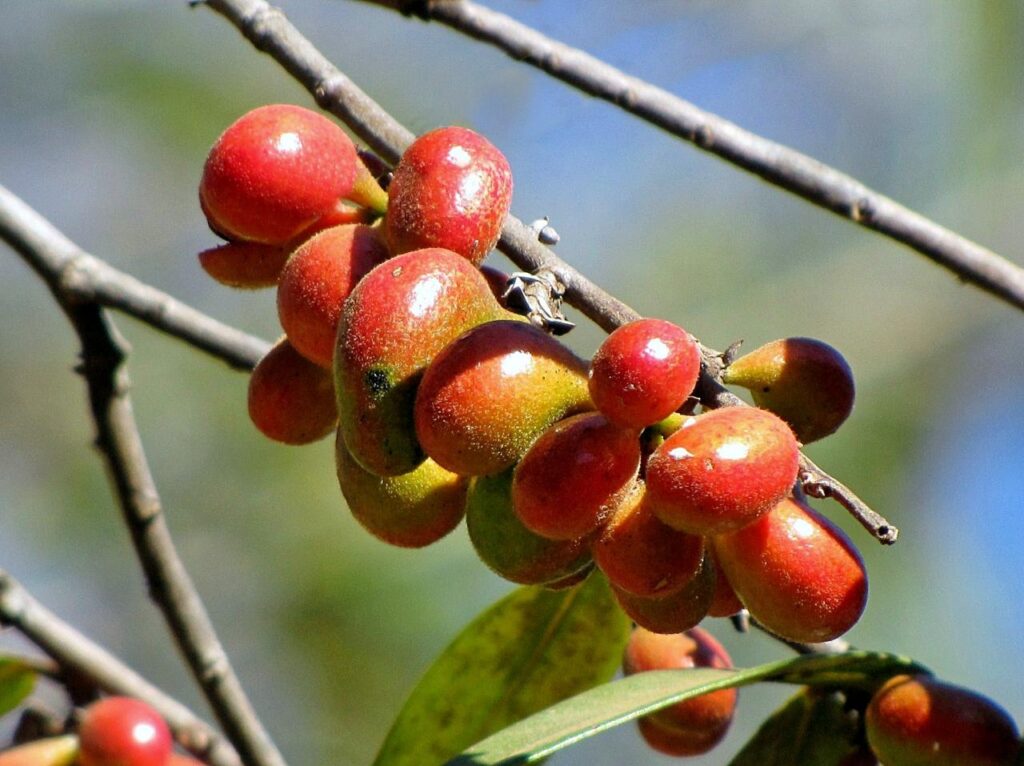
Xylopia sericea, also known as silky xylopia, has elongated leaves and produces small, fragrant white flowers.
The tree is known for its medicinal properties.
| Scientific Name | Xylopia sericea |
|---|---|
| Origin | South America |
| Light | Full sun |
| Temperature | 15°C to 30°C |
| Watering | Moderate |
| Soil | Well-drained |
Fun Facts:
- The bark and leaves are used in traditional medicine.
- The tree can grow up to 20 meters tall.
- It is known for its pleasant fragrance.
19. Xanthostemon verdugonianus
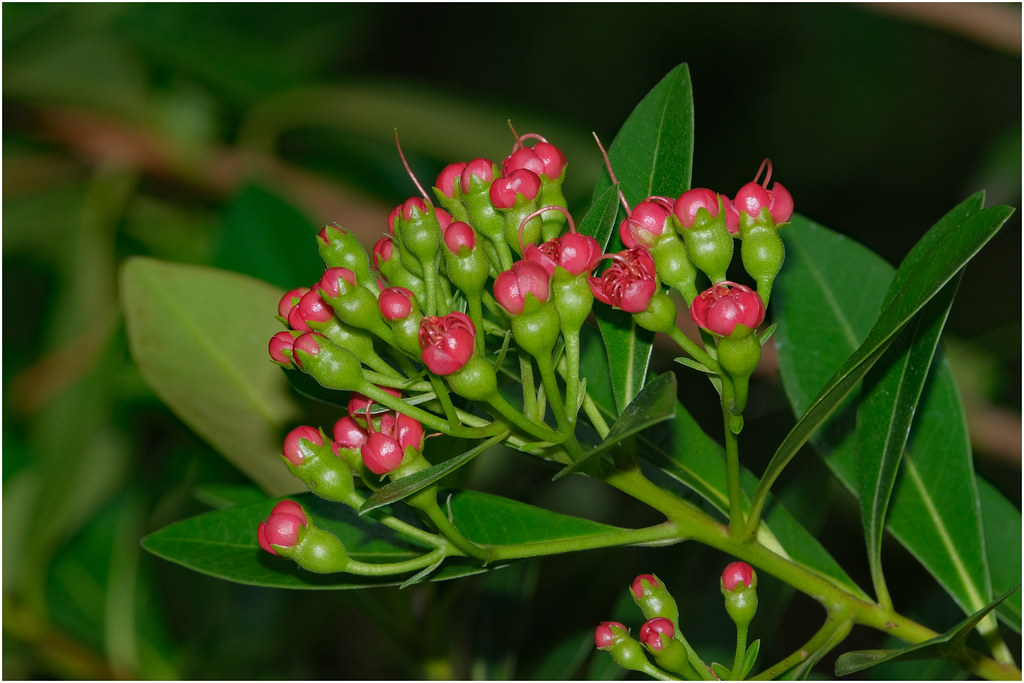
Xanthostemon verdugonianus, commonly known as mangkono or Philippine ironwood, has bright yellow flowers and dense, leathery leaves.
It is a slow-growing hardwood tree.
| Scientific Name | Xanthostemon verdugonianus |
|---|---|
| Origin | Philippines |
| Light | Full sun |
| Temperature | 20°C to 35°C |
| Watering | Moderate |
| Soil | Well-drained, loamy |
Fun Facts:
- The wood is extremely hard and durable.
- Often used in construction and shipbuilding.
- The tree is considered endangered in the wild.
20. Xiphidium caeruleum
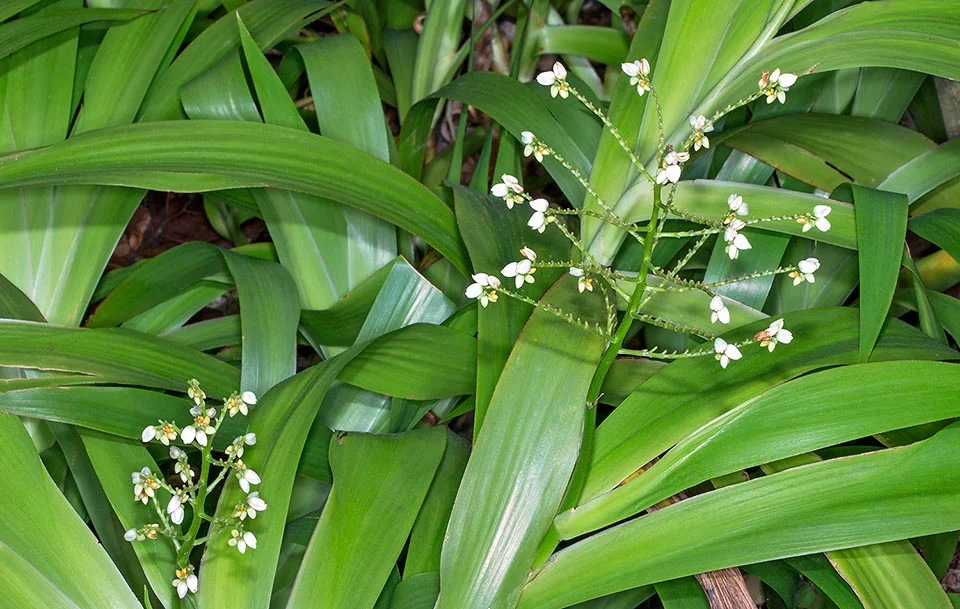
Xiphidium caeruleum, known as palm grass, has long, arching leaves and produces small, white to pale blue flowers.
The plant prefers moist, shaded environments.
| Scientific Name | Xiphidium caeruleum |
|---|---|
| Origin | Central America |
| Light | Partial shade |
| Temperature | 15°C to 30°C |
| Watering | High |
| Soil | Moist, well-drained |
Fun Facts:
- Often found in tropical rainforests.
- The flowers attract butterflies.
- It is used as an ornamental plant in shaded gardens.
21. Xylopia brasiliensis
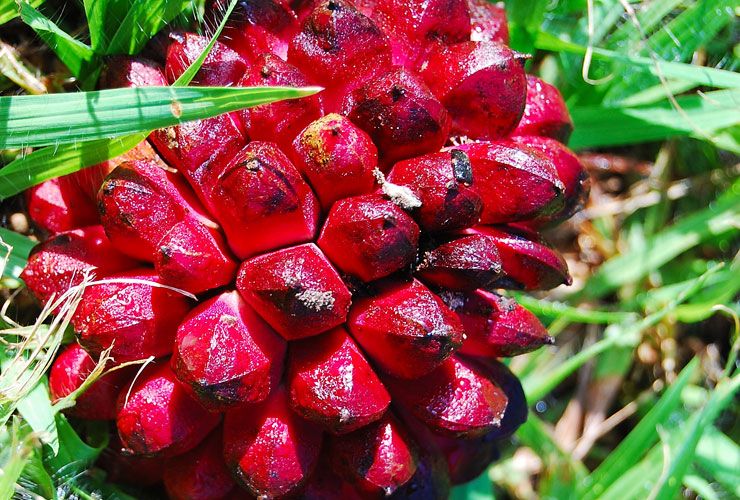
Xylopia brasiliensis, also known as Brazilian xylopia, has lance-shaped leaves and produces small, aromatic flowers.
The tree is known for its medicinal properties.
| Scientific Name | Xylopia brasiliensis |
|---|---|
| Origin | Brazil |
| Light | Full sun |
| Temperature | 15°C to 30°C |
| Watering | Moderate |
| Soil | Well-drained |
Fun Facts:
- The bark and leaves are used in traditional medicine.
- The tree can grow up to 15 meters tall.
- It is known for its pleasant fragrance.
22. Xeromphalina campanella
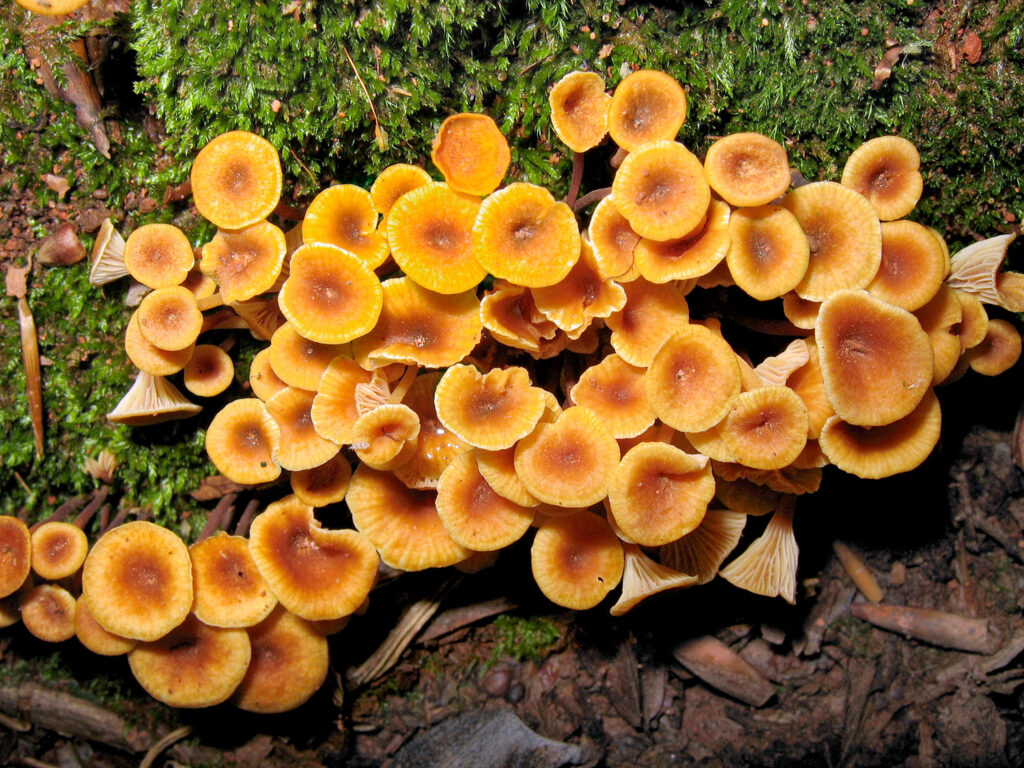
Xeromphalina campanella, commonly known as golden trumpet, is a small mushroom with a bright orange cap and thin, wiry stem.
It grows in clusters on decaying wood.
| Scientific Name | Xeromphalina campanella |
|---|---|
| Origin | North America |
| Light | Partial shade |
| Temperature | 5°C to 20°C |
| Watering | High |
| Soil | Decaying wood, moist |
Fun Facts:
- It is not edible but adds a splash of color to woodland gardens.
- Often found in damp, shaded forests.
- The mushrooms are short-lived and delicate.
23. Xeromphis spinosa
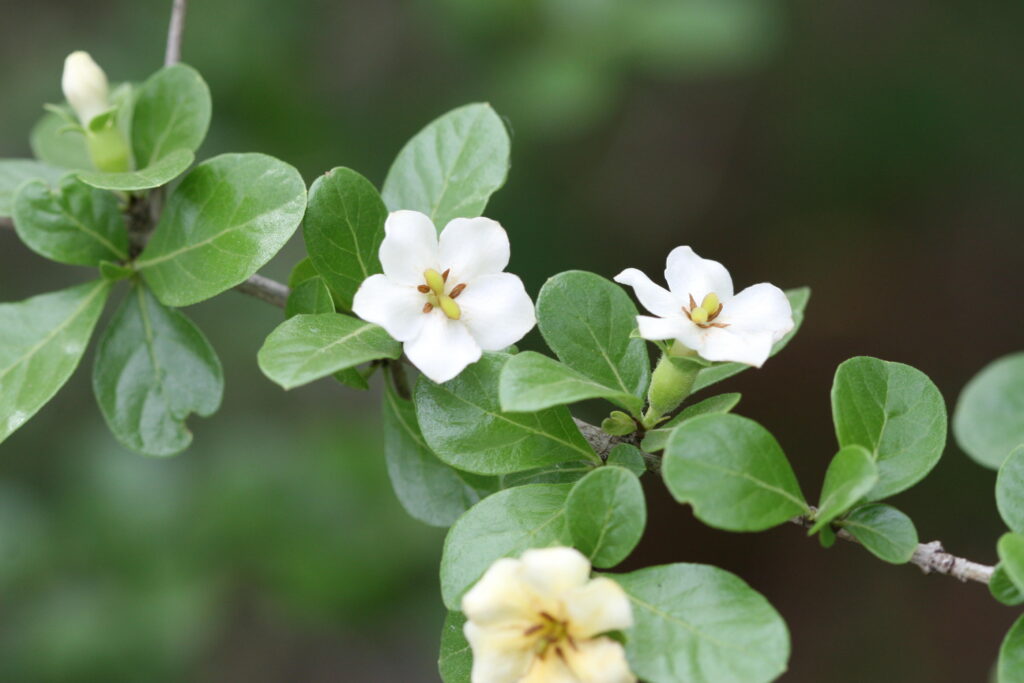
Xeromphis spinosa, commonly known as spiny bush, has thorny branches and small, greenish-white flowers.
The plant produces small, round fruits.
| Scientific Name | Xeromphis spinosa |
|---|---|
| Origin | Africa |
| Light | Full sun |
| Temperature | 20°C to 35°C |
| Watering | Low |
| Soil | Well-drained |
Fun Facts:
- It is often used as a natural fence due to its thorns.
- The fruits are edible and have a sweet taste.
- It is drought-tolerant and thrives in arid conditions.
24. Xylopia frutescens
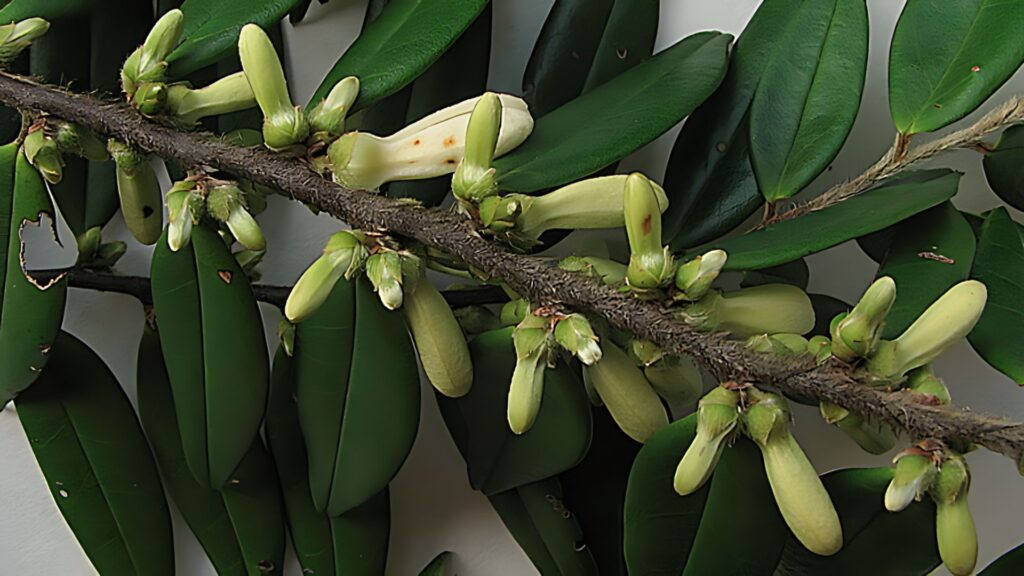
Xylopia frutescens, also known as shrubby xylopia, has elongated leaves and produces small, fragrant flowers.
The shrub is known for its medicinal properties.
| Scientific Name | Xylopia frutescens |
|---|---|
| Origin | South America |
| Light | Full sun |
| Temperature | 15°C to 30°C |
| Watering | Moderate |
| Soil | Well-drained |
Fun Facts:
- The bark and leaves are used in traditional medicine.
- The shrub can grow up to 3 meters tall.
- It is known for its pleasant fragrance.
25. Xylopia emarginata
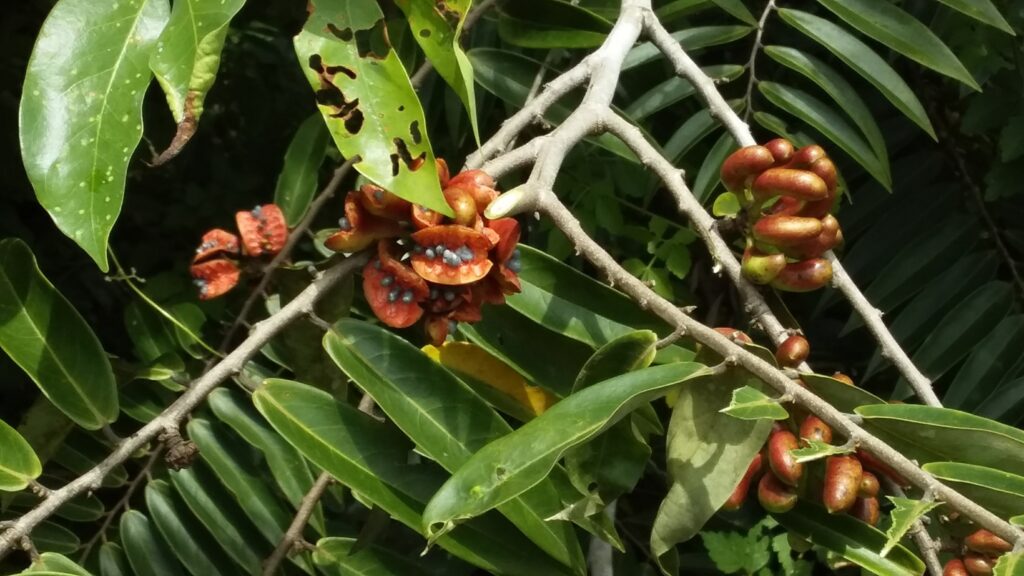
Xylopia emarginata, known as emarginated xylopia, has elongated leaves and produces small, aromatic flowers.
The tree is known for its medicinal properties.
| Scientific Name | Xylopia emarginata |
|---|---|
| Origin | South America |
| Light | Full sun |
| Temperature | 15°C to 30°C |
| Watering | Moderate |
| Soil | Well-drained |
Fun Facts:
- The bark and leaves are used in traditional medicine.
- The tree can grow up to 20 meters tall.
- It is known for its pleasant fragrance.
26. Xylopia nitida
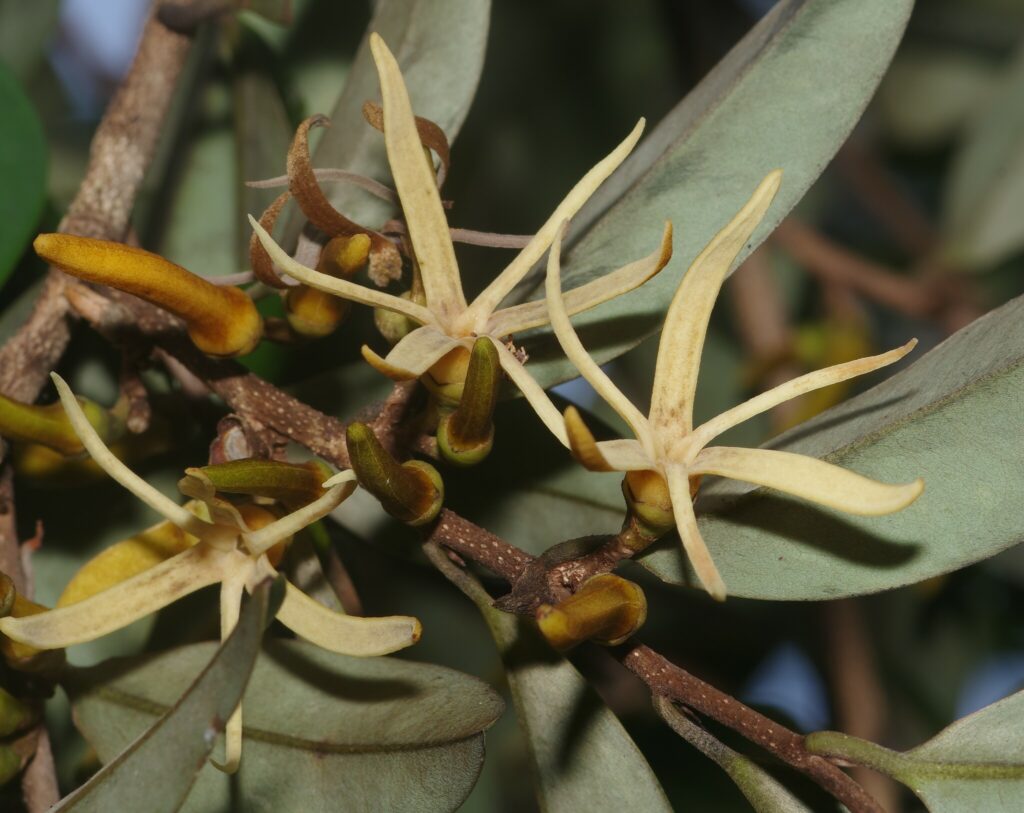
Xylopia nitida, also known as shiny xylopia, has glossy, lance-shaped leaves and produces small, fragrant flowers.
The tree is valued for its medicinal properties.
| Scientific Name | Xylopia nitida |
|---|---|
| Origin | South America |
| Light | Full sun |
| Temperature | 15°C to 30°C |
| Watering | Moderate |
| Soil | Well-drained |
Fun Facts:
- The bark and leaves are used in traditional medicine.
- The tree can grow up to 15 meters tall.
- It is known for its pleasant fragrance.
27. Ximenia caffra
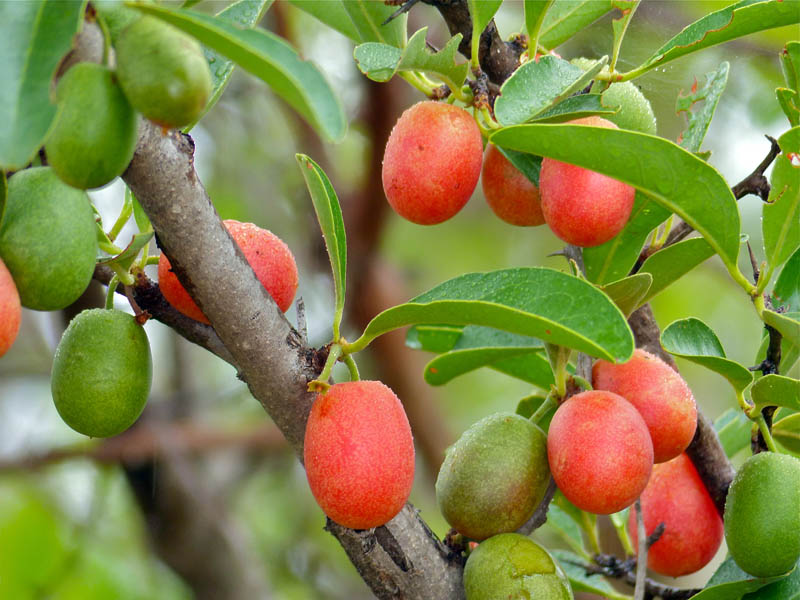
Ximenia caffra, commonly known as large sourplum, has leathery, oval leaves and produces small, fragrant flowers followed by red to orange fruits.
| Scientific Name | Ximenia caffra |
|---|---|
| Origin | Africa |
| Light | Full sun |
| Temperature | 15°C to 35°C |
| Watering | Moderate |
| Soil | Well-drained |
Fun Facts:
- The fruits are edible and used in jams and jellies.
- The plant has medicinal properties.
- The wood is used for making tools and utensils.
28. Xanthium spinosum
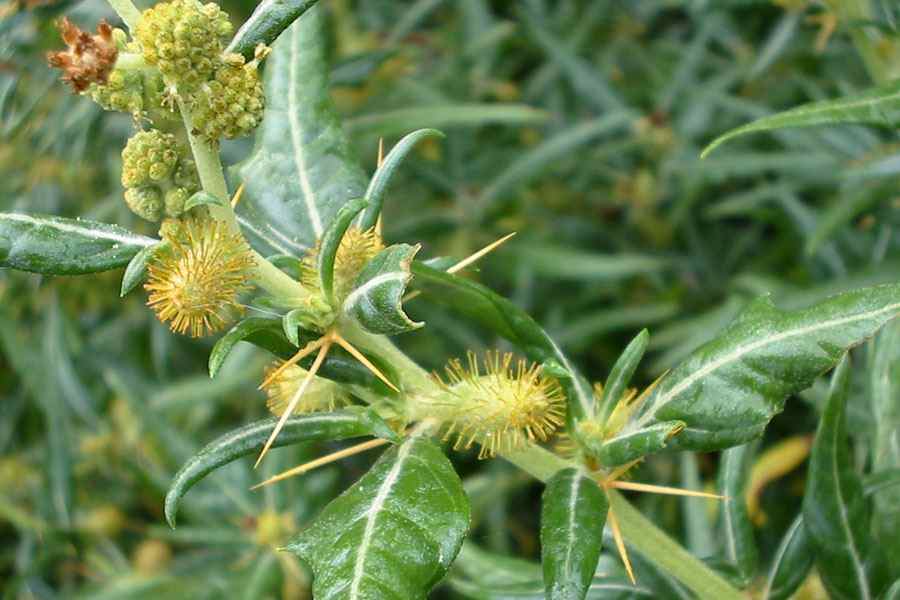
Xanthium spinosum, known as spiny cocklebur, has rough, lance-shaped leaves and produces spiny burs.
The plant is considered a weed in many areas.
| Scientific Name | Xanthium spinosum |
|---|---|
| Origin | South America |
| Light | Full sun |
| Temperature | 5°C to 30°C |
| Watering | Moderate |
| Soil | Well-drained |
Fun Facts:
- The burs can stick to animal fur and clothing.
- It has been used in traditional medicine.
- The plant is toxic to livestock if ingested.
29. Xerochrysum bracteatum
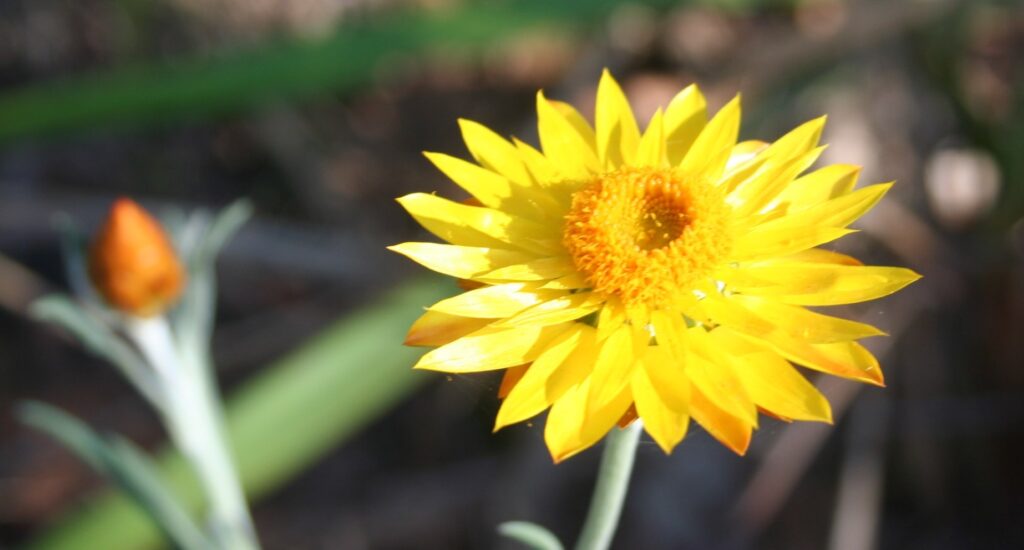
Xerochrysum bracteatum, commonly known as the golden everlasting or strawflower, features vibrant, daisy-like flowers in a range of colors, including yellow, orange, pink, and white.
The plant has silvery-green foliage and blooms throughout the summer.
| Scientific Name | Xerochrysum bracteatum |
|---|---|
| Origin | Australia |
| Light | Full sun |
| Temperature | 5°C to 30°C |
| Watering | Moderate |
| Soil | Well-drained, sandy |
Fun Facts:
- The flowers retain their color and shape when dried.
- Often used in floral arrangements and crafts.
- It attracts butterflies and other pollinators.
30. Xylorhiza venusta

Xylorhiza venusta, also known as the beautiful woody aster, has lavender to blue flowers with yellow centers.
The plant has woody stems and lance-shaped leaves.
| Scientific Name | Xylorhiza venusta |
|---|---|
| Origin | North America |
| Light | Full sun |
| Temperature | -10°C to 30°C |
| Watering | Low |
| Soil | Well-drained, sandy |
Fun Facts:
- It is drought-tolerant and ideal for xeriscaping.
- The flowers bloom in late spring to early summer.
- Often found in desert regions and rocky slopes.
31. Xerophyta viscosa
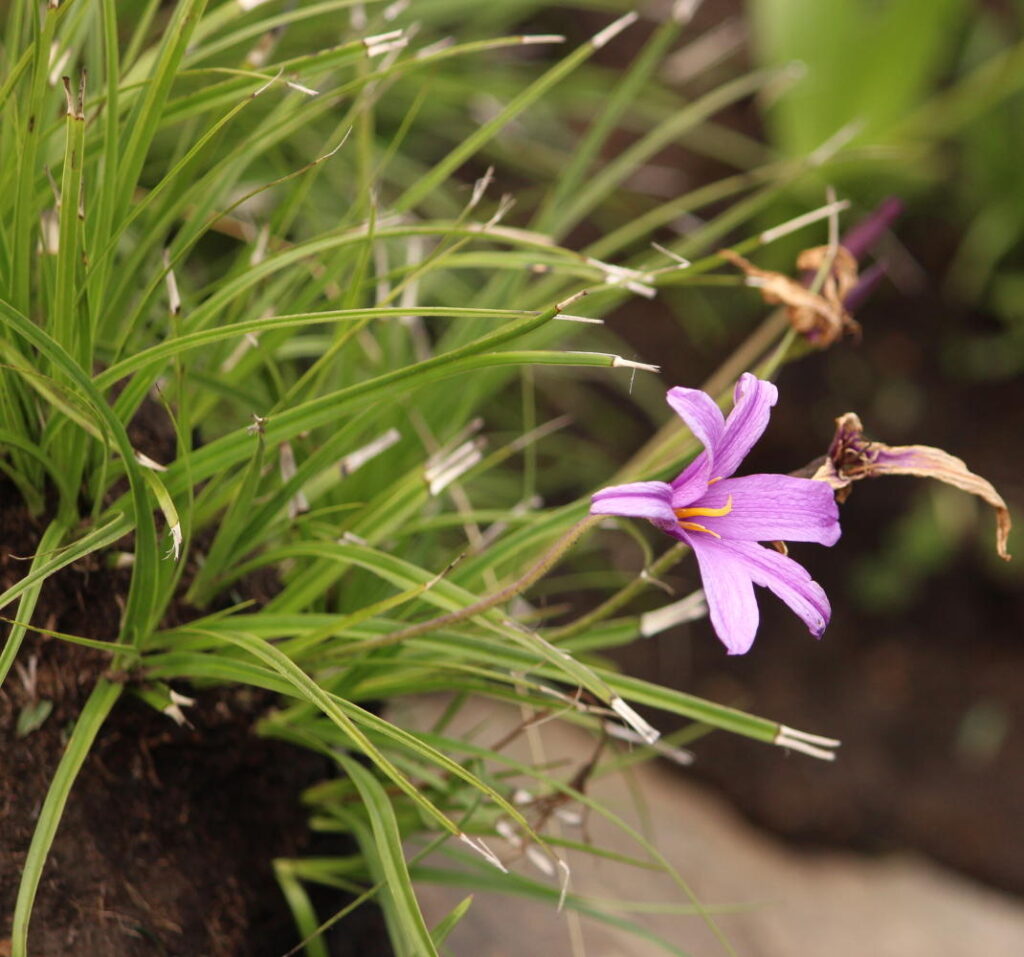
Xerophyta viscosa, commonly known as the resurrection plant, has grass-like leaves that turn brown and curl up during drought but revive with water.
The plant produces small, white to pink flowers.
| Scientific Name | Xerophyta viscosa |
|---|---|
| Origin | Southern Africa |
| Light | Full sun |
| Temperature | 10°C to 35°C |
| Watering | Low |
| Soil | Well-drained, rocky |
Fun Facts:
- It is known for its ability to survive extreme drought conditions.
- Often found in rocky, mountainous areas.
- The plant can live for many years and is used in traditional medicine.
32. Xylosma longifolia
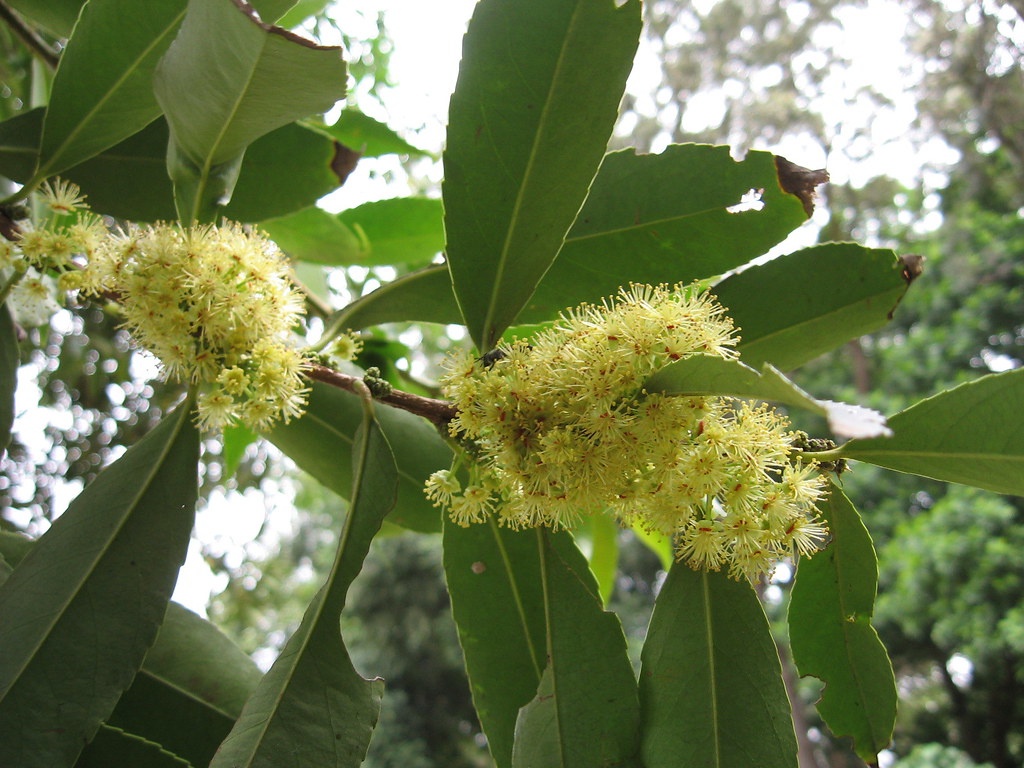
Xylosma longifolia, also known as longleaf xylosma, is an evergreen shrub with long, glossy green leaves.
It produces small, fragrant yellow flowers followed by dark berries.
| Scientific Name | Xylosma longifolia |
|---|---|
| Origin | Southeast Asia |
| Light | Full sun to partial shade |
| Temperature | 10°C to 30°C |
| Watering | Moderate |
| Soil | Well-drained |
Fun Facts:
- Often used as a hedge or ornamental shrub.
- The berries are attractive to birds.
- It is low-maintenance and adaptable to various soils.
33. Xylocarpus granatum
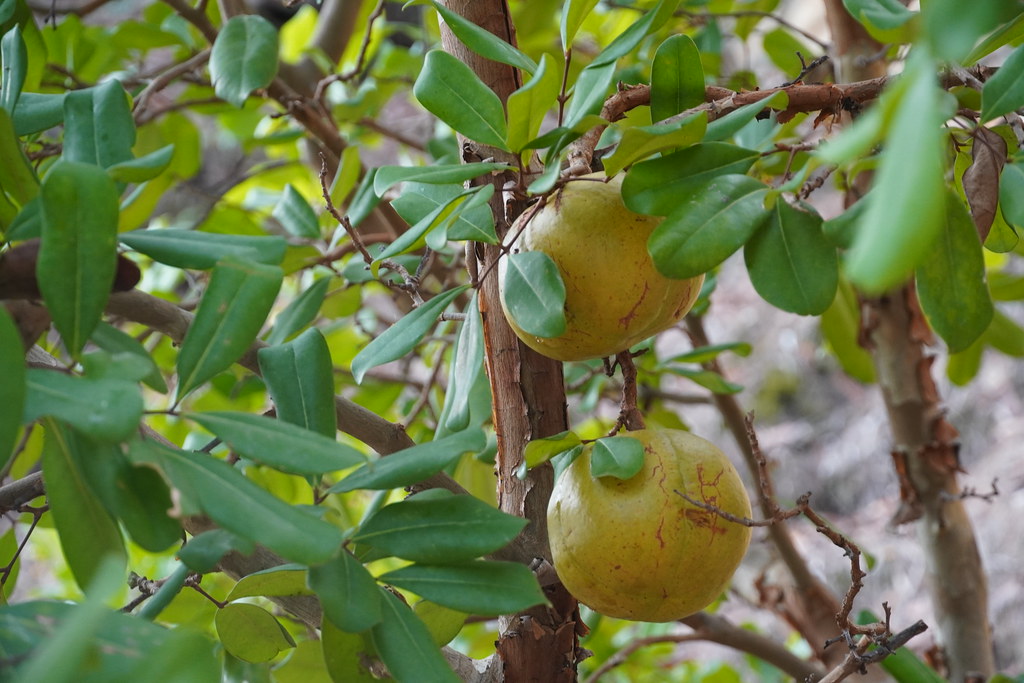
Xylocarpus granatum, known as the cannonball mangrove, has compound leaves and produces large, spherical fruits that resemble cannonballs.
The tree has a dense, rounded canopy.
| Scientific Name | Xylocarpus granatum |
|---|---|
| Origin | Coastal regions of the Indo-Pacific |
| Light | Full sun to partial shade |
| Temperature | 20°C to 35°C |
| Watering | High |
| Soil | Well-drained, saline |
Fun Facts:
- The fruit is large and can be used as a floatation device.
- It is an important species for coastal protection.
- The wood is used in boat building and furniture making.
Conclusion
I hope you’ve enjoyed learning about these unique plants, starting with X. From xanthium to xylosma, there’s a surprising variety out there.
Why does this matter? Well, adding these lesser-known plants to your garden can make it stand out. They’re great conversation starters and can add interesting textures and colors to your outdoor space.
What’s next? I encourage you to pick one or two X-plants that caught your eye and try growing them. Whether you choose the vibrant xylobium or the hardy xerophyllum, you’ll add something special to your garden.
If you’ve had experience with any of these plants, I’d love to hear about it. Leave a comment below sharing your stories or asking questions.
Let’s continue the conversation and learn from each other’s gardening adventures!

